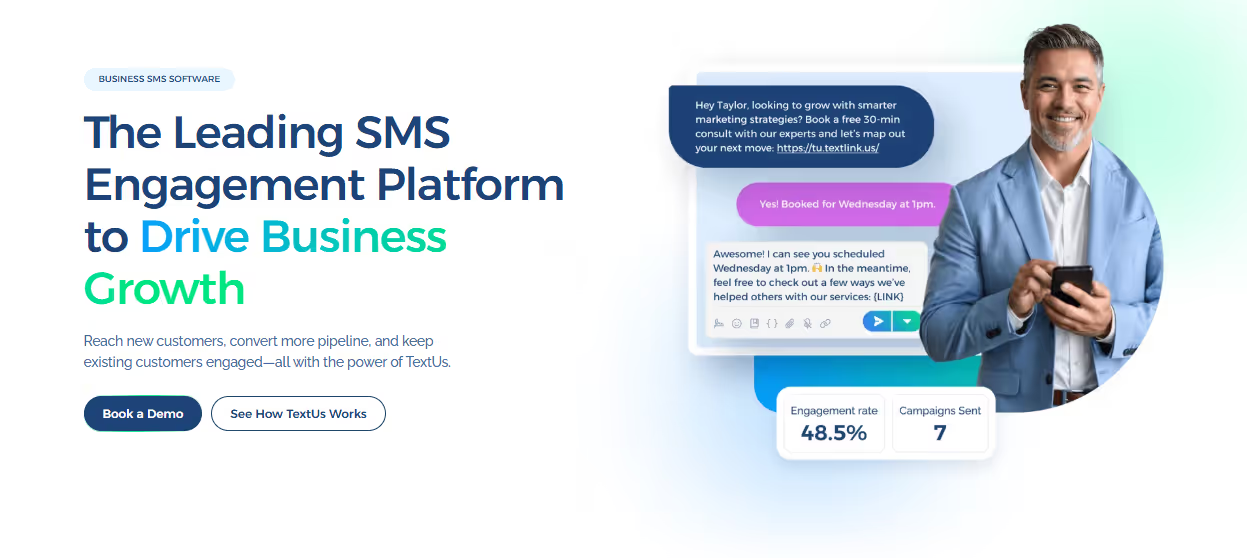When Is the Best Time to Send SMS Marketing Campaigns?
Read to find out the best time to send SMS marketing campaigns, from the best time of day to the best calendar dates.
Published
November 3, 2025

You can craft the perfect SMS marketing campaign, add a tempting offer, and still miss your chance if you send it at the wrong time.
Business text messaging can be powerful. But success depends on understanding your audience’s daily routine.
People check their phones constantly, but not all hours deliver the same results. Early mornings feel intrusive, while late nights often go unnoticed.
The best send time helps you reach customers when they’re ready to read and respond, turning every message into a chance to connect.
In this guide, you’ll learn the best time to send SMS marketing and why you need to adjust timing by industry, message type, and campaign goal for optimal results.
Best Time of Day to Send SMS Marketing Texts
People react to marketing messages according to their everyday schedule and habits. Morning, afternoon, and evening hours each carry advantages that vary depending on your target market and offer type.
Weekdays
Weekdays remain the strongest period for sending SMS marketing messages, as people check their phones frequently throughout the workday. But the key lies in knowing when they are most likely to open and act on your message.
9 AM – 12 PM
Morning hours capture attention before people go to work. Many check their phones for updates, reminders, and event reminders while sipping coffee or settling into their tasks.
This is the perfect window for time-sensitive offers or appointment reminders. Messages sent within this timeframe usually reach users before their inboxes or notifications get crowded.
5 PM – 9 PM
The early evening window consistently produces higher engagement. People have finished work, are commuting, or relaxing at home. They’re more likely to browse offers, read promotions, or respond to texts.
Campaigns sent between these hours often achieve stronger campaign performance, especially when paired with limited-time incentives or flash sales.
The most productive time within that range falls between 7 PM and 9 PM. This slot stands out as the “power hour” if you want to maximize engagement.
This is the time when most distractions fade, and people can focus on what’s on their screens. Texts sent here generate more clicks and follow-throughs.
Sending SMS campaigns outside business hours risks losing attention. During quiet hours or off-peak hours, messages are read too late to matter.
You should match the timing of your SMS to your industry and customer habits, daily patterns, and time zone differences, rather than sending randomly.
Weekends
Timing shifts on weekends because routines change. People spend less time on work-related tasks and more on relaxation, errands, or weekend plans.
The right approach is to find moments when they are active on their phones but not overwhelmed with other activities.
10 AM – 12 PM (Saturday)
Late morning on Saturdays delivers steady customer engagement. People are awake, relaxed, and browsing messages over breakfast or coffee.
Promotional messages sent during this time stand out because inboxes are quieter compared to weekdays. Brands running weekend sales, flash deals, or event updates often see solid responses from this window.
4 PM – 7 PM (Sunday)
Sunday evenings present another opportunity. By this time, most have finished their activities and are preparing for the week ahead.
Sales messages that include reminders, offers, or helpful content perform well here because recipients are more receptive and reflective. The tone of your text blast should stay friendly, short, and focused on value, not pressure.
You can also follow a two-step approach. For instance, you can send a short SMS message on Thursday giving exclusive access to weekend discounts. Then, you may follow up with a Saturday reminder. This keeps your brand memorable without being intrusive.
Avoid sending messages during off-peak hours or late at night. While weekends invite more personal time, they also mean different phone habits. People may silence notifications or ignore messages that arrive too early or too late.
Best Days of the Week for SMS Campaigns
The right day to send SMS marketing messages matters almost as much as the time. Each day carries its own pace, and results often vary depending on mood, habits, and schedules.
Thursday
This day frequently delivers the strongest results for engaging customers.
People have moved past midweek fatigue and start preparing for weekend plans. They’re relaxed, optimistic, and more likely to read and act on SMS marketing and email messages.
Retail and restaurant promotions perform especially well on Thursdays because customers are planning outings and purchases.
Friday
The end of the workweek encourages impulse decisions. People are in better moods and open to spontaneous buying.
Messages that highlight exclusive access or limited-time deals spark interest and clicks. Friday evenings work best for leisure-related or event-based offers since recipients are planning how they’ll spend their free time.
Saturday
Saturday provides a unique opportunity for you to send SMS blasts. People check their phones often but receive fewer promotional messages, giving your campaign more visibility.
This day suits brands sending bulk SMS campaigns focused on weekend sales, dining, or entertainment. The lack of competition during these hours makes your message stand out more easily.
Sunday
While not as strong as Thursday or Friday, Sunday evenings still perform well for reminders or marketing texts tied to upcoming events.
As people prepare for the week, they are more attentive to practical messages such as appointments, schedules, or final-day sales.
Best Calendar Dates to Send SMS Messages
Consumer spending patterns shift throughout the month, and recognizing these changes helps your campaigns reach customers at moments when they’re most willing to receive messages.
Middle of the Month (14th–17th)
This period performs well as customers have adjusted their budgets and feel more comfortable spending on non-essential items.
Messages promoting new sales, seasonal offers, or limited deals see higher conversions. A mid-month text blast can remind shoppers about upcoming promotions or highlight early access to discounts.
End of the Month (29th–31st)
The final days of the month bring another boost. Many people receive paychecks or bonuses, leaving them with extra spending power.
Campaigns featuring higher-value products or payday specials perform strongly here. Timing your SMS blasts around this cycle creates a sense of convenience. Customers already plan to spend, and your message gives them a reason to do it sooner.
Seasonal and Event-Based SMS Opportunities
Certain times of the year present powerful opportunities to connect with your SMS subscribers. Seasonal trends, holidays, and cultural events create predictable surges in engagement and spending.
Major Holidays
Peak seasons such as Christmas, New Year’s, and Valentine’s Day create ideal conditions for sales-driven communication. Campaigns sent during these periods often see higher open and click rates because target customers expect deals.
A message shared a few days before a holiday works best for reminders, discounts, or last-minute promotions. Consistent communication keeps your brand present during these high-spending moments.
Seasonal Sales and Events
Big shopping days like Black Friday, Cyber Monday, and end-of-season clearances invite strong engagement. SMS marketing campaigns highlighting special offers or limited stock perform best.
A call to action in your bulk SMS marketing, such as “Shop Now” or “Grab Your Discount Today,” encourages quick responses. Slow months can focus on educational content or loyalty rewards to keep your audience interested until the next sale cycle.
Cultural and Regional Observances
Events tied to local traditions, such as Ramadan, Mother’s Day, or regional festivals, influence how people shop. Data on customer behavior helps adjust your messaging strategy to fit each audience.
If you run a cafe, you might promote breakfast bundles before a local event, while you can highlight gift discounts during cultural celebrations for your retail store.
Yearly Patterns
Consumer spending tends to repeat around the same time each year. Predictable buying patterns make it easier to plan text marketing campaigns.
Customers who expect deals from your brand during familiar sales periods stay more engaged and are less likely to ignore future messages.
How Often You Should Send SMS Campaigns
Balance matters when planning your SMS marketing efforts. The best approach focuses on consistent communication that always adds value.
Most businesses send text blasts 2-4 times per month. That range works for maintaining visibility without overwhelming your subscribers.
Some industries, like retail or restaurants, may contact customers more frequently during holidays or major local events. Campaigns that include helpful reminders or limited-time offers perform best when sent at the optimal time for your audience.
Each text message should serve a specific purpose. Messages that deliver exclusive deals, useful updates, or educational content keep people interested and loyal. Irrelevant or repetitive texts lead to fatigue and higher opt-out rates.
Frequency should also match your business goals. If you're focused on building loyalty, you might send weekly check-ins or updates about rewards programs.
If you're centered on fast-moving sales, you could send marketing text messages during short promotions or new sales periods.
Subscribers who voluntarily sign up expect personal communication. Therefore, you need to respect their time to keep your SMS strategy sustainable in the long term.
Useful Tips to Improve Timing Accuracy
Strong results depend on more than just choosing a time slot. Small adjustments create big differences in how your SMS marketing performs. Here’s how you can make every message hit:
Segment Your Audience
Different customers behave in various ways. SMS segmentation based on purchase history, engagement level, or location helps you send messages that match individual routines.
Age, job type, and lifestyle affect how people handle notifications. Office workers respond during phone calls or breaks, while younger audiences prefer evening alerts.
Scheduling your SMS based on where subscribers live also prevents off-peak hours messages from arriving too early or too late.
You can also group subscribers by shopping or engagement behavior. Loyal customers can receive updates more often, while new subscribers opt for fewer but more personalized texts.
Automate Based on Data
Manual scheduling can only go so far. Automation backed by performance insights helps your campaigns reach people at the perfect moment without constant supervision.
SMS marketing automation helps you track engagement trends and send scheduled messages based on customer behavior.
For example, if most users open marketing text messages around lunch, the system automatically adjusts future sends to match that pattern. This data-driven scheduling keeps every campaign aligned with audience habits.
With the best SMS marketing software, you can continue learning from campaign data. The more SMS messages you send, the more accurate your scheduling becomes. Over time, automation helps maintain steady conversion rates and minimizes unsubscribes.
Automate smarter and make every message count. Book a demo today and see how TextUs keeps your outreach consistent!
Run A/B Tests
A/B testing, also known as split testing, compares two or more versions of a message to reveal what resonates best with your target audience.
One group might respond quickly to marketing text messages sent in the morning, while another reacts better in the evening. Once you compare these results, you uncover reliable patterns in customer behavior that shape future campaigns and keep your business moving forward.
You can start small by testing variations in:
- Send time: Morning vs. afternoon vs. evening
- Message type: Short alerts vs. detailed marketing texts
- Tone or offer: Urgent discounts vs. soft reminders
- Call to action: “Shop Now” vs. “Claim Offer”
You can track key metrics such as open rate, click-through rate, and unsubscribe rate. Even small differences reveal valuable insights.
If Group A responds stronger to SMS messages at noon and Group B prefers after work, that data builds a stronger SMS strategy in the future.
Sync With Other Channels
Timing across platforms shapes how customers experience your brand. Each channel should support the same message.
You can pair your text marketing updates with email marketing campaigns and social media posts that share the same theme. When messages arrive within the same day, they appear intentional rather than repetitive.
Email suits longer updates, while SMS messages drive faster responses. A short text message reminder later in the day can reinforce a morning email announcement about a sale or event. The mix of formats captures attention from active readers and busy customers.
Automate Your Timing, Simplify Your Sales—Try TextUs!
Timing can turn a simple text into a sale, and with TextUs, perfect timing becomes effortless.
TextUs helps you master communication timing with intelligent scheduling, automation, and analytics. The platform gives you full control over when your texts go out, so your messages align with real customer behavior.
You can schedule campaigns that reach people before their day gets busy, during breaks, or in the evening when engagement peaks. Each message fits naturally into your customer’s routine, which boosts the visibility and response rates of your campaigns.
Success in SMS marketing comes down to consistency, timing, and connection. TextUs helps you check all three boxes by making your outreach smarter and more predictable.

Book a demo with TextUs today and reach your audience when they’re ready to act!
FAQs About the Best Time to Send SMS Marketing
What are quiet hours for SMS marketing?
Quiet hours refer to the times when sending SMS messages is considered inappropriate or intrusive. Most regions define quiet hours between 9 PM and 8 AM, though this can vary by location and industry.
You need to respect these boundaries to avoid complaints and keep your SMS strategy compliant. Messages sent during late-night hours can trigger negative feedback or even spam filters. Therefore, you have to check local guidelines before scheduling.
How often should I send SMS marketing?
Most brands find success sending marketing text messages 2-4 times per month. This frequency keeps your text subscribers engaged without overwhelming them.
The ideal rhythm depends on customer preferences, seasonal promotions, and audience type. Data suggests that brands communicating consistently but not excessively can see stronger engagement.
Is SMS's open rate 98%?
Yes. Studies confirm that SMS open rates average around 98%, far higher than typical email campaign results.
The reason is that people keep their phones close and read messages within minutes. The visibility of SMS makes it a powerful component of digital marketing strategies aimed at real-time engagement.
On what day of the year are the most text messages sent?
Christmas Day consistently sees a peak in the number of traditional SMS text messages sent. People use this time to greet loved ones and celebrate the occasion.
This trend emphasizes how emotional and social moments influence engagement. Campaigns timed around holidays and peak connection periods avoid rush hour competition and take advantage of naturally high interaction levels.
Continue Reading
Frequently Asked Questions
Business Texting
Built for Results
Create and convert pipeline at scale through industry leading SMS software




